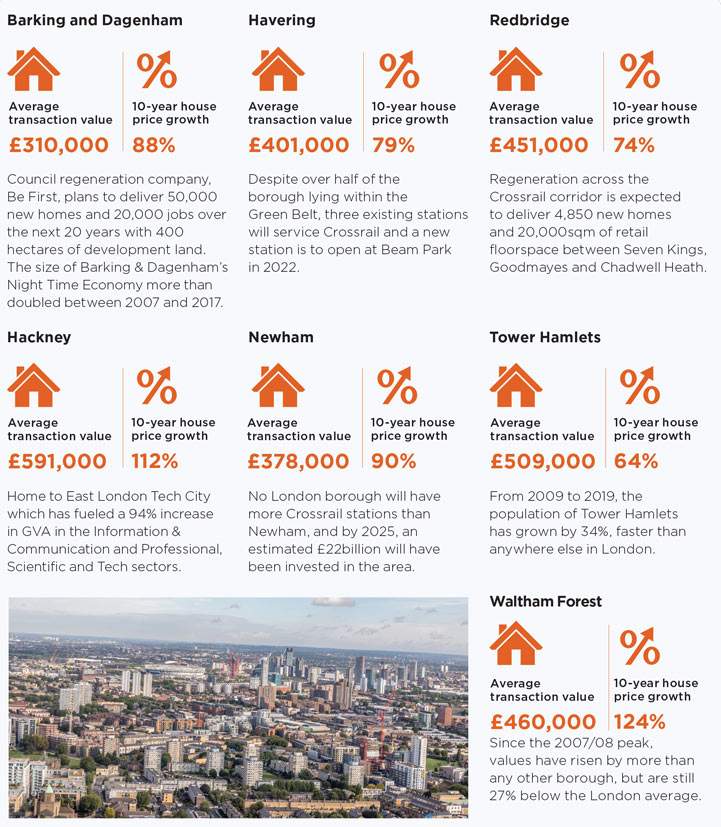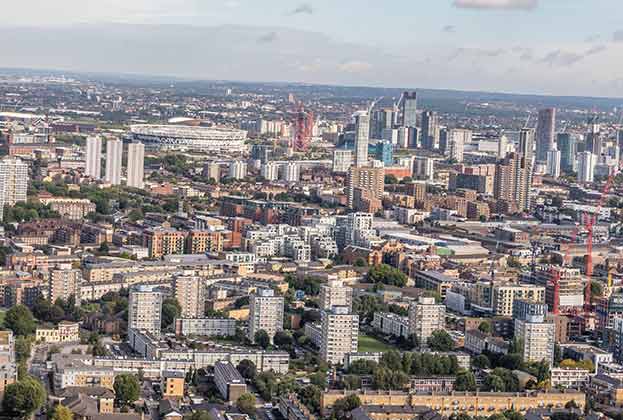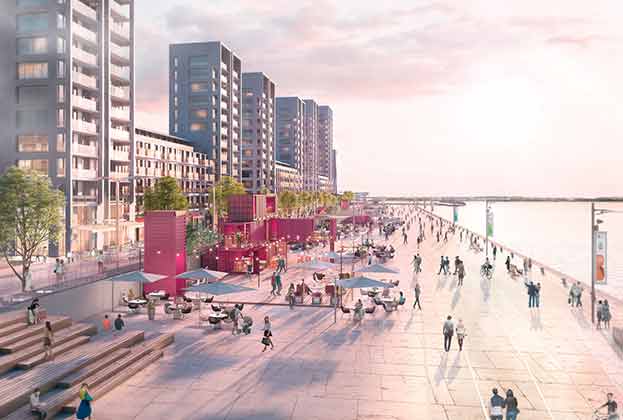Emerging and affordable but under-supplied
The unaffordability of London has been well documented in recent years, with home ownership seemingly out of reach for many. Over the last ten years, the average house price in London has risen by 83%, vastly outstripping income growth. The Eastern Corridor is one of the few remaining areas that is relatively affordable.
Despite the significant development and investment in recent years, there is still expected to be a further influx of demand for housing once Crossrail is complete and operational, presenting an opportunity for developers to put themselves in a position to capitalise on this current and future demand.
A change of scene
While large parts of East London are covered by industrial buildings and cheap housing, the scene is changing, with a helping hand from Crossrail which, when fully functioning, will open up scores of new opportunities and connectivity between East and central London. This change has already been seen over the last decade. From 2009 to 2019, the value of goods and services produced in the Information & Communication and Professional, Scientific and Tech sectors in East London has increased by 72%, whilst population growth in the area has increased by 19%, both at a rate higher than the London average.
From 2009 to 2019, the value of goods and services produced in the Information & Communication and Professional, Scientific and Tech sectors in East London has increased by 72%
Savills Research
The younger generation also has reason to look east. Hackney, Barking and Dagenham and Newham lead the way when it comes to the increase in cultural and leisure services in the Night Time economy between 2007 and 2017, with all East London boroughs performing better than the London average. Furthermore, the emergence of Shoreditch’s Tech City has attracted swathes of young professionals and Here East has contributed to a buzzing student scene. Loughborough University, University College London and Staffordshire University all now have campuses on at the Queen Elizabeth Olympic Park.
Unique in its affordability
East London is one of the only areas which can offer affordable market housing to the average Londoner. Four of the seven cheapest boroughs are situated in East London, and when Crossrail is fully functioning, residents will no longer have to sacrifice convenient travel times to live in East London.
The new Crossrail line will service 14 stations outside zone 1, compared to just eight in West London, highlighting the importance the line will play in unlocking opportunities in the Eastern Corridor. Travel times into key employment hubs will be cut by 35% in places such as Ilford, and convert eastern town centres into a more viable option for commuting into central London.
Compared to areas in other parts of London that can offer similar travel times, East London locations are significantly more affordable. Journeys from Romford to the nearest three major employment hubs take 30–35 minutes, but the area has average residential transaction values 13% lower than a West London equivalent in West Drayton, and is nearly half the value of Southgate in the north, and Streatham in the south. Even Stratford which is one of East London’s most expensive locations, which with Crossrail will see travel times cut to under 15 minutes, offers significant value compared to the comparable locations of South Kensington and Camden Town.
Residential values by travel time from main employment hubs
.jpg)
Source: Savills Research, Land Registry
At a price point desperately needed in London
In London, the shortfall in supply is not evenly spread across price points. We calculate that 70% of demand for buying or renting is for housing below £450psf and sub-market housing, but just 30% of forecasted completions throughout 2020–2024 are expected to come through at this price point. This is where the greatest shortfall in supply is, and where the greatest opportunity exists for developers. This also highlights the opportunity for developers in East London particularly, with the new build £psf in large parts of Barking and Dagenham and town centres such as Ilford and Romford falling below £450psf.
The upper mainstream market (£700psf-£1,000psf) is likely to be fully supplied over the next five years, with high levels of competition and slower sales rates to be expected. Although, and despite being in the early stages of consultation, the 30% discount proposed for First Homes is likely to open up opportunities in these markets. Due to the already low capital values in the Eastern Corridor, this discount could make homes at this price point more affordable, unlike in other parts of London where the homes would remain unaffordable due to higher starting capital values.
East London offers potential to deliver new homes at the price they are most needed
.jpg)
Source: Savills Research, Land Registry, MHCLG, EGi, Molior
Supply isn’t keeping up
Despite the recent increase in housing delivery post-Olympics in East London, it faces the same supply challenge as the rest of London. Over the three years to Q1 2019, only Hackney has delivered the required number of homes set out in the 2019 Planning Inspectorate’s review of the London Plan. Havering and Barking and Dagenham face the largest challenge in meeting their new targets, currently delivering just 21% and 28% of their targets respectively. If supply continues to fail to keep up with the growing demand for housing in this area, this could see the affordability advantage evaporate in East London.
However, Barking and Dagenham and Havering are the two local authorities whose councils have the greatest development ambitions for the next five years. Lifting the Housing Revenue Account (HRA) debt cap has contributed to an increase in development activity from local councils, specifically from local housing companies.
The next five years
Forecasted capital value growth in mainstream London is relatively muted at 4% over the next five years, and predominantly restricted by mortgage affordability. However, the lower capital values means this is less of a pressure in the Eastern Corridor, giving it the opportunity to outperform other parts of London.
Summary
The Eastern Corridor has been firmly put on the map with the help of Crossrail, putting the connectivity of East London now on par with some of the more traditionally aspirational parts of London towards the West. Whilst investment into the area has picked up in recent years, it has remained the most affordable part of London, and when Crossrail is up and running the demand in these areas will be huge. There is still a large undersupply of housing in this part of London, and therefore an opportunity for developers to put themselves in a position to absorb the strong demand.
East London locations
London’s Eastern Corridor spans from Stratford to Havering. It is the most affordable stretch of London despite significant investment in infrastructure and large clusters of development. When Crossrail fully opens, connectivity to central employment hubs will improve vastly, with potentially huge levels of demand waiting in the wings to capitalise.

Source: Land Registry
Read the articles within London Development: Eastern Corridor below.
.jpg)

